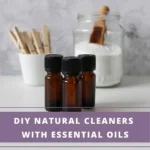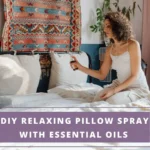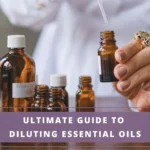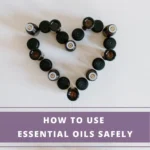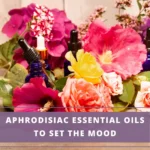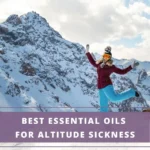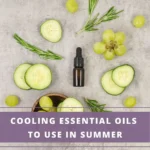As an Amazon Associate I earn from qualifying purchases. See Full Disclosure Here
Pollen allergies can turn a promising spring season into a nightmare of sniffling, sneezing, and puffy eyes. These 12 simple, easy, and effective ways to reduce pollen allergy symptoms naturally can make a world of a difference!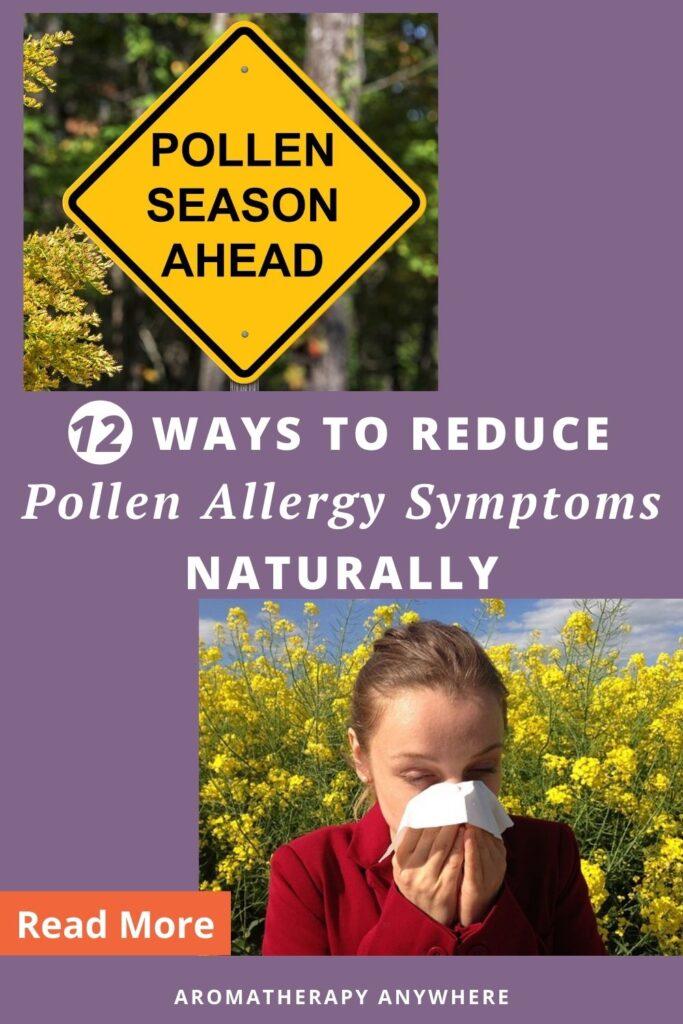
Pollen allergies are particularly prominent in spring when the pollen count is high.
Trying to avoid coming in contact with pollen can feel impossible – it seems to be everywhere, and not just outdoors either. You open the windows to let the refreshing spring breezes indoors and those allergy-causing pollen particles get in too.
Impossible as it may seem, there are simple everyday things you can do to prevent those annoying pollen allergies.
But first… a look at what causes pollen allergies.
What Causes Pollen Allergies?
Pollen allergies are caused by pollen, a fine powdery substance produced by flowering plants.
Pollen is vital to plant reproduction. In spring, which is the blooming season, plants produce large quantities of pollen, which is transported by wind, bees, and butterflies.
When pollen becomes airborne and is inhaled, it can trigger allergies in some people. This is because their body identifies pollen as a threat. An allergy is in fact the result of the immune system overreacting to a foreign substance – in this case, pollen.
When the immune system encounters a threat, it releases a type of antibody called immunoglobulin E (IgE), which binds to the pollen particles and triggers the release of histamine and other chemicals.
These chemicals cause inflammation and irritation in the nose, throat, eyes, and other parts of the body, leading to symptoms such as sneezing, runny nose, itching, and watery eyes.
The severity of pollen allergy symptoms can vary depending on the type and amount of pollen present in the environment, as well as your sensitivity to pollen.
In some cases, pollen allergy symptoms can be severe and interfere with daily activities, while in others, they may be mild and easily managed with over-the-counter or prescription medications.
The type of plant that causes an allergy also varies from person to person. Some people may be allergic to pollen from one type of plant while others may be allergic to other types of plants.
Common Pollen Allergy Symptoms
Common pollen allergy symptoms may include one or more of the following:
– Runny or stuffy nose: The respiratory system may produce excessive amounts of clear, thin mucus or become congested with thick mucus, making it difficult to breathe through the nostrils.
– Sneezing: Sneezing is the body’s way of getting rid of the foreign particles that have entered the nasal passage. Though the constant sneezing may be annoying, it’s actually a good thing. It helps to get rid of some of the pollen in the nose.
– Watery, itchy, or red eyes: These pollen allergy symptoms occur when the eyes come in contact with allergens such as pollen. It is known as allergic conjunctivitis.
– Itchy nose, throat, or ears: Itching in the nose, throat, or ears can be persistent and uncomfortable. These are also caused by the body’s overreacting immune system.
– Fatigue: The body’s immune response to pollen can be draining, and some people may feel fatigued or tired as a result.
– Postnasal drip: Postnasal drip is caused by the mucus from the nose and sinuses dripping down the back of the throat. It can lead to coughing or sore throat, and may also cause a bad taste in the mouth or nausea.
Some of the less common but equally annoying pollen allergy symptoms include headaches due to inflammation in the sinuses, skin irritation such as eczema or hives, and difficulty breathing or shortness of breath.
12 Easy, Simple, & Effective Ways To Reduce Pollen Allergies Naturally
1. Clean all indoor surfaces thoroughly
Don’t underestimate the power of a clean environment. Pollen particles that find their way indoors settle down on all surfaces and remain there for days if not wiped away. These invisible particles can trigger your pollen allergy symptoms if you touch the surface and then touch your face.
Disturbing the particles also increases the risk of allergies. Because they are so light, pollen particles easily rise and fly around unseen indoors. Inhaling these light, invisible allergens can cause irritation to build up.
Wiping down surfaces with a damp cloth is one of the simplest ways to keep indoor allergens at bay.
Always use natural cleaners. Harsh chemicals in commercial cleaners can irritate your nasal passages and aggravate your symptoms. This Multi-Surface Cleaner Concentrate with essential oils is perfect for the purpose.
Read ‘how to allergy-proof your home against pollen‘ for 16 easy ways to reduce the amount of pollen that gets into the house.
2. Use A Mask When Stepping Outdoors
Wearing a mask is the single most effective way to reduce pollen allergy symptoms when stepping outdoors. Pollen-allergy masks come in a wide range of protection levels, from basic protection to high-level protection for those who experience severe pollen allergy symptoms.
Put that mask on while spending time outdoors, whether time forest bathing, working in your backyard, or just walking around the park. All of these outdoor activities offer several health benefits.
Wearing a pollen-allergy mask allows you to enjoy these activities and get the benefits of connecting with nature without having to deal with the annoying symptoms.
You can also find a wide range of pollen-allergy masks for kids. They come in a range of bright colors and are smaller in size so they provide a snug fit for smaller faces.
3. Close Your Windows On Days When The Pollen Count Is High
It feels good to have fresh spring breezes blowing through the window. But unfortunately, they carry pollen particles indoors with them. These particles settle down everywhere, from the walls and floors to the furniture, drapes, and even your clothes. They then proceed to trigger your allergies even if you don’t step outside.
Closing your windows on high pollen count days will prevent pollen from getting indoors limiting your exposure and minimizing the symptoms.
4. Use An Air Purifier For Allergies
Installing an air purifier can be very effective at reducing pollen allergy symptoms. They work by eliminating pollen particles from the indoor environment.
The best air purifiers for allergies are designed with multiple layers of filters, each one designed to do a different job.
– The outermost layer consists of a pre-filter. A charcoal filter forms the second layer. They both work together to trap larger particles from the environment and eliminate odors.
– The smaller-sized particles that pass through are then captured by a true HEPA filter, which forms the last layer. The HEPA filter is designed to capture the smallest particles, including pollen particles and mold spores. The air that leaves the HEPA filter and re-enters the environment is free from pollen particles and other contaminants.
Using an air purifier during peak pollen season eliminates the pollen that gets inside your home, reducing pollen allergy symptoms. This is a great way to keep your indoor air allergen-free.
Read my review of the GermGuardian AC4825 With True Hepa Filter.
If humidity levels are high where you live, using a dehumidifier with an air filter is a better choice. Read more about the link between high humidity levels and allergies and how a dehumidifier helps reduce allergy symptoms.
5. Change Your Clothes As Soon As You Enter The House
You can’t possibly spend the entire spring season indoors. You have to go outside some time or the other and when you do, some pollen will settle on your clothes and shoes.
Changing your clothes as soon as you get indoors will limit their spread around the hours. Throw your clothes in a closed laundry basket until wash day so the pollen particles can’t escape.
If you can, leave your shoes outdoors. Alternatively, keep a brush or cloth outside the door and brush or dust your shoes off before you walk through the door.
6. Wash your face and hands as soon as you come indoors
When you step outdoors, pollen can settle on exposed areas of your skin just as it settles on your clothes. Washing your face and hands will get rid of the allergens from your skin, further reducing the risk of pollen allergy symptoms.
A quick shower is even better. It will wash off any lingering traces of pollen from your skin and hair. This will allow you to get on with the rest of your day without sniffling and sneezing because of the pollen.
If you’re tempted to soak in a bathtub, it’s a good idea to shower first and then get in the tub. The shower will wash off any pollen particles from your skin. Otherwise, they will just float on the water and trigger your allergies.
7. Use Essential Oils For Allergy Symptoms
Lemon– Inhaling the aroma of lemon oil is known to open the sinuses and ease chest congestion.
Peppermint– Peppermint helps respiration by calming the sensitive tissues in your lungs and breathing passages.
Eucalyptus– Eucalyptus contains menthol, an ingredient that is used in several cold and sinus medicines. Inhaling the cool menthol aroma helps to clear the sinuses.
Blue Tansy – This rare essential oil is best known for its anti-inflammatory properties, making it the perfect go-to when those pesky allergy seasons roll through
Frankincense– Its anti-inflammatory properties make frankincense very effective for reducing pollen allergy symptoms.
Clear Again Essential Oil Blend– Clear Again Synergy was created to help alleviate respiratory symptoms, especially during times of high seasonal pollen.
Breathe Ease Essential Oil Blend – This menthol-rich essential oil from Rocky Mountain Oils contains a unique combination of respiratory-boosting essential oils that help promote your body’s ability to break up mucus or phlegm caused by pollen allergies. Its soothing menthol aroma can calm your respiratory system and make it easier to get full, deep breaths.
How to use essential oils to reduce pollen allergy symptoms
For outdoor use, add 1-2 drops and 100 ml water in a personal inhaler and carry it with you.
For indoor use, use your preferred essential oil or blend aromatically by adding 1-2 drops per 100 ml of water in your diffuser.
To use topically, dilute your chosen essential oil to 2 – 4% in a carrier oil and apply. Keep this dilution chart handy so you can refer to it whenever you need to dilute essential oils.
You may also be interested in “Best Essential Oils For Allergies And How To Use Them”
8. Use A Neti Pot Regularly
Doing a nasal rinse using a neti pot will clear pollen particles from the nasal passage, preventing those irritating symptoms.
A neti pot is a simple device that has a container and a spout. You fill the container with a saline mixture, place the spout into your nose and tilt the container. The saline irrigates your nasal cavity as it enters one nasal cavity and goes out the other. During its passage, it washes away any allergens that may be lodged in the cilia or mucous membrane.
If you’ve never used a neti pot before, you can find everything you need to know in these two articles:
What is a Neti Pot & How To Use It
How To Use A Neti Pot To Reduce Pollen Allergies
9. Change Your Diet to Manage Allergy Symptoms
Tweaking your diet is another easy way to reduce pollen allergy symptoms naturally. We are not talking about what you should take away as much as what you can add to your diet to help.
These are some foods you should add to your daily diet to help suppress allergy symptoms.
• Plenty of fresh vegetables and fruits, especially apples, tomatoes, and grapes
• Locally-sourced raw honey – some studies show that consuming local honey can help protect you from the allergic effects of endemic plants.
• Fruits rich in Vitamin C, including kiwi, oranges, and melon
• Consume sufficient Omega-3 Fatty acids – these antioxidants have a profound effect on reducing pollen allergies
• Drink plenty of water – it helps replenish the bodily fluids that you lose from sniffling and also thins down the mucus in your nasal passages, easing the congestion
10. Do Regular Steam Inhalations
 Inhaling steam eases a stuffy nose and helps you breathe easier. This is because the heat from the steam loosens the mucous, making it easier to get rid of. This also gets rid of the allergen particles adhering to the mucous.
Inhaling steam eases a stuffy nose and helps you breathe easier. This is because the heat from the steam loosens the mucous, making it easier to get rid of. This also gets rid of the allergen particles adhering to the mucous.
To do steam inhalation, pour steaming water (not boiling) in a bowl. Hold your head over the bowl, place a towel over your head to trap the steam, and inhale.
Be careful not to fill the bowl too much and make sure to place the bowl on a flat, steady surface. The water will be hot. You don’t want the bowl toppling over.
Adding a few drops of eucalyptus oil will make the steam inhalation doubly effective.
Alternately, sit in the bathroom with a hot shower running and let the steam engulf you.
11. Clean Your Pets Before Bringing Them Indoors
Nobody gives much thought to pets and pollen. After a romp around outdoors, pollen and other irritants are sure to get lodged in their fur and their paws. Your pets can bring huge amounts of allergens indoors.
Keep a fur brush at the door. Before letting your pets come back indoors, brush their fur thoroughly to get rid of persistent pollen particles.
12. Dry Your Laundry Indoors
Avoid hanging your clothes outside during peak pollen season. It’s really easy for clothes to collect a large amount of pollen and other allergens while hanging out to dry. These irritants will end up in your home and trigger allergic responses.
Hanging your clothes to dry in an area that’s well-ventilated but protected from exposure to allergen particles is a surprisingly effective way to reduce pollen allergy symptoms.
You may also be interested in:
Natural Remedies For Seasonal Allergies
Fall vs. Spring Allergies: Is There A Difference?
Himalayan Salt Lamp Benefits For Seasonal Pollen Allergies
Reducing pollen allergy symptoms is one of 10 reasons for keeping a Himalayan salt lamp in your home

Disclaimer: This information is not intended to serve as medical advice. Please consult your physician before using essential oils. See Full Disclaimer here.


